Yam vs Sweet Potato
In the world of root vegetables, yams and sweet potatoes often cause confusion. They look similar but are actually different in many ways. Knowing the difference is important for those who love to cook and eat healthy.
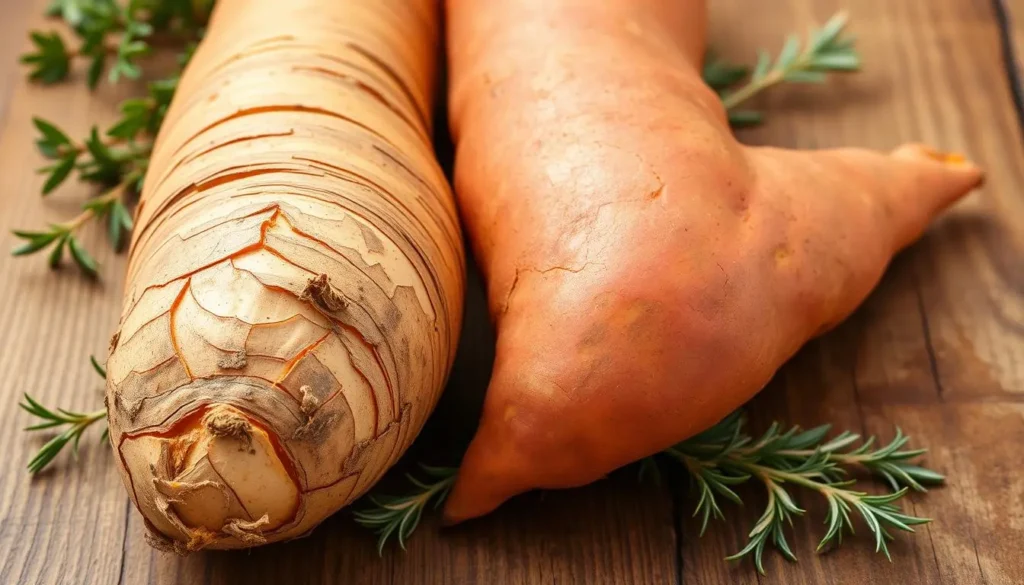
Key Takeaways
- Yams and sweet potatoes are different root vegetables with distinct botanical origins.
- Sweet potatoes come in a variety of colors, including orange, yellow, and white, while yams are typically white, purple, or reddish-brown.
- Yams tend to be drier and starchier than sweet potatoes, which are naturally sweeter and more moist.
- Nutritionally, sweet potatoes are packed with more vitamins, minerals, and antioxidants compared to yams.
- Yams and sweet potatoes have different culinary uses and cooking methods, with sweet potatoes being more versatile in the kitchen.
Introduction to Yams and Sweet Potatoes
Yams and sweet potatoes are two different root vegetables. They are often mixed up, but knowing their differences is key for cooking and health.
What Are Yams?
Yams are a starchy root from Africa and Asia. They vary in shape, size, and color, from white to purple. Yams are drier and starchier than sweet potatoes, with a firmer texture.
They are a main food in many cultures. They’re used in many traditional dishes.
What Are Sweet Potatoes?
Sweet potatoes are a root from the Americas. They’re sometimes called “yams,” but they’re not the same. Sweet potatoes are softer, sweeter, and moister than yams. They have a bright orange or purple inside.
The mix-up between yams and sweet potatoes comes from using “yam” for some sweet potatoes. This has caused a lot of confusion about their differences.
Botanical Classification
Yams and sweet potatoes have different plant families. Yams are tubers, while sweet potatoes are root vegetables.
Yams come from the Dioscorea genus in the Dioscoreaceae family. They are from Africa and Asia and have been grown for thousands of years. Sweet potatoes, on the other hand, are from the Ipomoea genus in the Convolvulaceae family. They are from the Americas and were a key food for many indigenous cultures before European explorers arrived.
| Characteristic | Yams | Sweet Potatoes |
|---|---|---|
| Botanical Classification | Dioscorea genus, Dioscoreaceae family | Ipomoea genus, Convolvulaceae family |
| Native Origin | Africa and Asia | Americas |
| Plant Type | Tubers | Root vegetables |
The history and where these crops come from shape their differences. Knowing these basics helps us see what makes yams and sweet potatoes special.
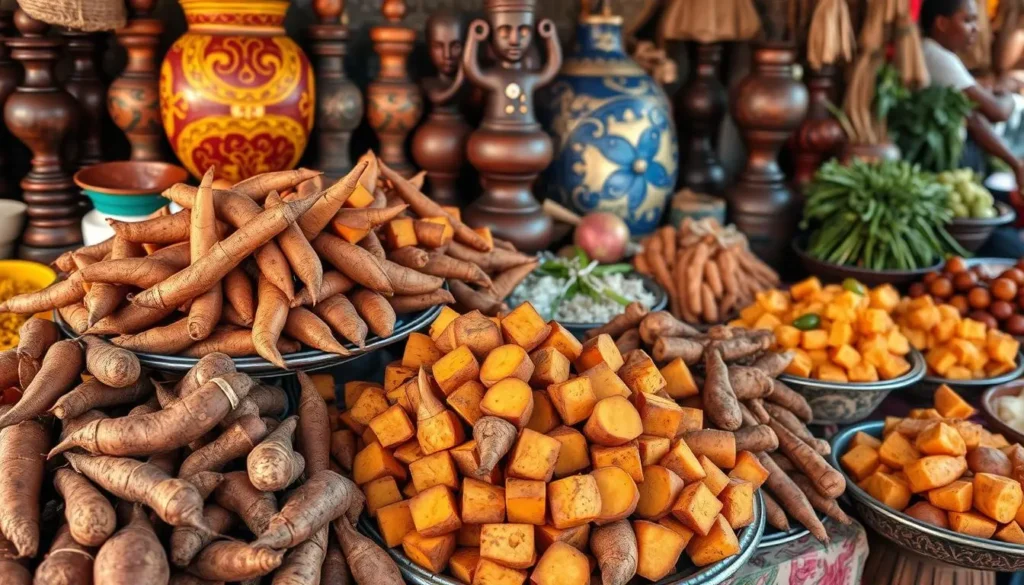
Physical Appearance and Varieties
Yams and sweet potatoes look similar at first, but they are different. They belong to different families and have unique colors, flesh, shapes, and sizes. This variety makes them great for cooking.
Yam Varieties
Yams come in many types, each with its own look. You can find the Okinawan yam with its purple skin or the white yam that’s long and thin. There’s also the yellow yam with creamy flesh and the red yam with its deep color.
Yams can be small or big, weighing a few pounds. They add variety to any dish.
Sweet Potato Varieties
Sweet potatoes also have many types. The orange-fleshed sweet potato is well-known, but there are others too. You can find white, yellow, and purple sweet potatoes, each with its own taste and texture.
The Beauregard and Jewel sweet potatoes are bright orange. The Japanese Sweet Potato is purple on the outside and sweet inside.
| Yam Varieties | Sweet Potato Varieties |
|---|---|
| Okinawan Yam White Yam Yellow Yam Red Yam | Orange-fleshed Sweet Potato Beauregard Jewel Japanese Sweet Potato |
Whether you like yams or sweet potatoes, there’s something for everyone. The variety of options means you can find the perfect tuber for any dish.
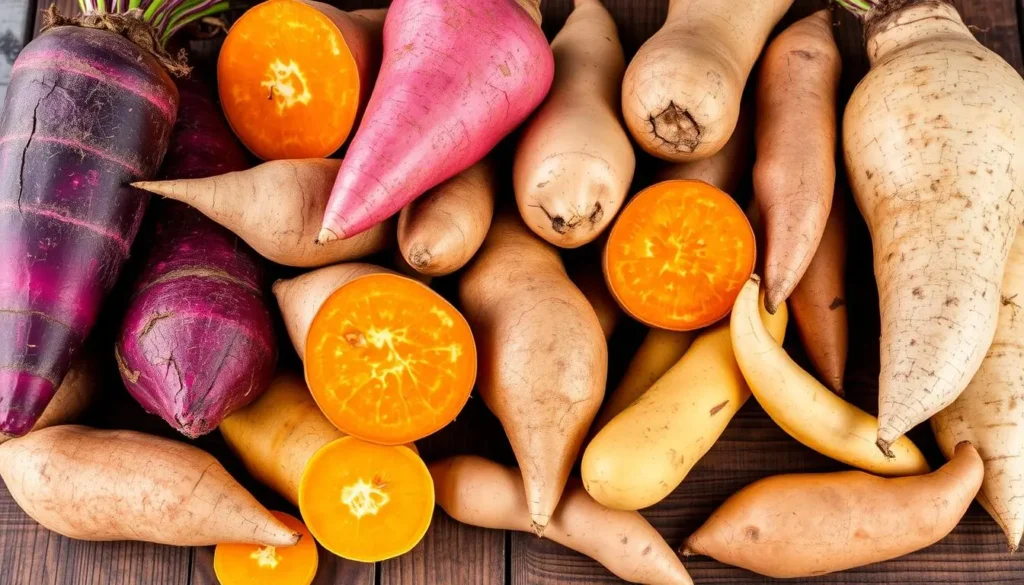
Nutritional Comparison
Yams and sweet potatoes are both packed with nutrients. But they have some key differences. Knowing these can help us choose the best for our diets.
Yam Nutrition Facts
Yams are rich in vitamin C, vitamin B6, and manganese. They also have a lot of dietary fiber, potassium, and copper. But, they have less beta-carotene than sweet potatoes.
Sweet Potato Nutrition Facts
Sweet potatoes are known for their beta-carotene, which makes them orange. They’re also full of vitamin A, vitamin C, and manganese. Plus, they offer dietary fiber, potassium, and vitamin B6.
| Nutrient | Yams | Sweet Potatoes |
|---|---|---|
| Calories | 118 per 100g | 86 per 100g |
| Carbohydrates | 27.9g per 100g | 20.1g per 100g |
| Fiber | 4.1g per 100g | 3g per 100g |
| Vitamin A | 2.4 μg per 100g | 14187 μg per 100g |
| Vitamin C | 17.1 mg per 100g | 2.4 mg per 100g |
Both yams and sweet potatoes are full of nutrients. But they have some differences. Knowing these can help us pick the best for our healthy diets.
Flavor Profiles and Taste
Yams and sweet potatoes are two root vegetables with unique flavors. They look similar but taste differently. Exploring their tastes is fascinating.
Yams have a starchy, earthy, and slightly nutty taste. They feel dense and dry but become creamy when cooked. Their sweetness is complex, with hints of caramel and vanilla.
Sweet potatoes, on the other hand, are very sweet and taste like candy. Their color ranges from yellow to orange. They taste like honey, brown sugar, and cinnamon, with a soft, moist texture.
| Yam Flavor | Sweet Potato Flavor |
|---|---|
| Starchy, earthy, and slightly nutty | Sweet, honey-like, and almost candy-like |
| Dense, dry, and creamy texture | Soft, moist, and silky texture |
Yams and sweet potatoes are great for many dishes. Yams work well in savory dishes and desserts. Sweet potatoes are perfect for both sweet and savory recipes.
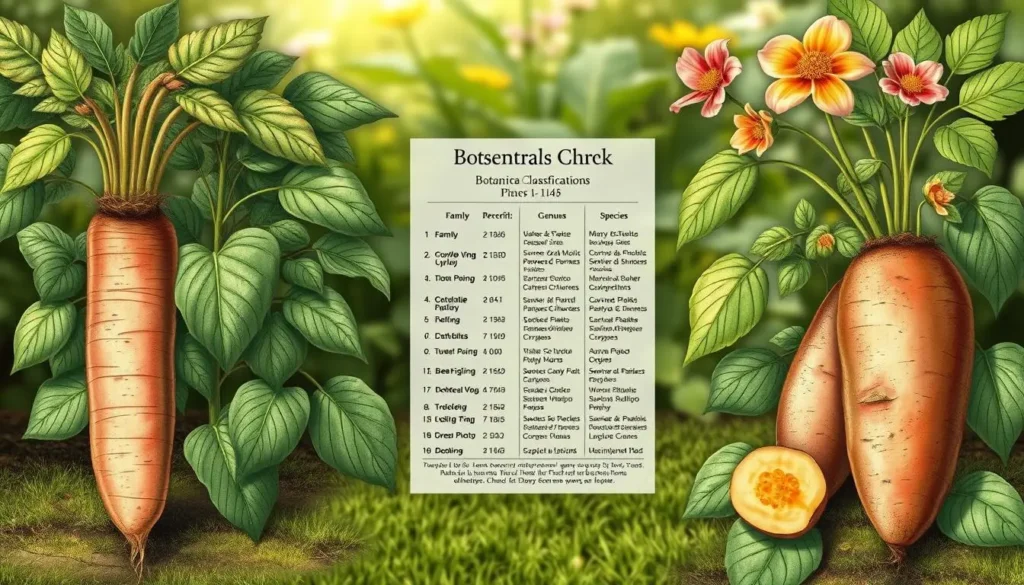
“Yams and sweet potatoes are like culinary soul mates, each with their own unique charm and ability to elevate a dish to new heights of flavor.”
Culinary Uses and Cooking Methods
Yams and sweet potatoes are super versatile. They can be cooked in many ways. This lets chefs and home cooks add them to lots of tasty dishes. You can roast, bake, sauté, or boil them, opening up a world of flavors.
Yam Cooking Methods
Yams can be enjoyed in many ways. Each method shows off their special texture and taste. Here are some popular ways to cook yams:
- Roasting: Cut yams into cubes or wedges, toss with oil, and season. Roast at high heat for a crispy outside and soft inside.
- Boiling: Boil whole or cubed yams until they’re soft. Then, mash, purée, or add to stews and soups.
- Sautéing: Slice or dice yams thinly. Sauté them in oil or butter for a tasty side or stir-fry ingredient.
- Baking: Bake whole yams until they’re tender. Top with butter, spices, or other toppings you like.
Sweet Potato Cooking Methods
Sweet potatoes are also very versatile. They can be prepared in many ways, each showing off their natural sweetness and creamy texture:
- Roasting: Roast sweet potato wedges or cubes at high heat. This caramelizes their sugars, making them crispy on the outside.
- Baking: Bake whole sweet potatoes until they’re tender. Enjoy them as a simple side or as a base for toppings and fillings.
- Grilling: Grill sweet potato slices or spears. This adds a smoky flavor and char.
- Mashing: Boil or steam sweet potatoes, then mash and season. This makes a creamy, comforting side dish.
Both yams and sweet potatoes can be used in many dishes, from savory meals to sweet treats. They offer endless chances for creative and tasty recipes.
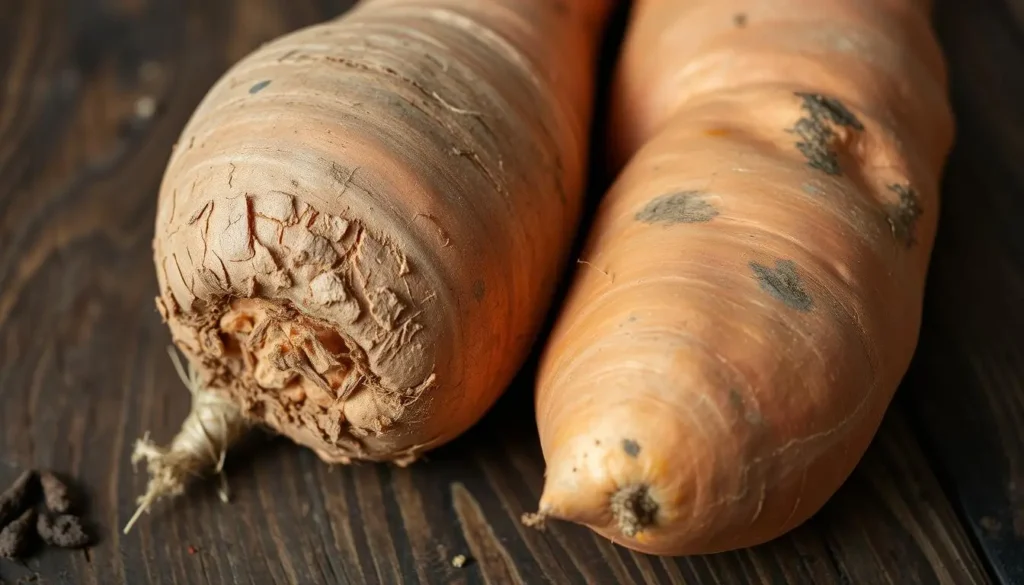
Yam vs Sweet Potato
Yams and sweet potatoes look similar but are different root vegetables. Knowing the difference between yams and sweet potatoes is key when picking ingredients for cooking.
Yams are in the Dioscorea family, while sweet potatoes are in the Ipomoea family. This difference affects their looks, nutrition, and how we use them in cooking.
| Characteristic | Yams | Sweet Potatoes |
|---|---|---|
| Appearance | Rough, scaly skin and starchy, dry flesh | Smooth, thin skin and moist, sweet flesh |
| Flavor | Earthy, nutty, and less sweet | Sweet, with a hint of creaminess |
| Nutritional Profile | Higher in carbohydrates, vitamin C, and potassium | Higher in vitamin A, vitamin B6, and fiber |
| Culinary Uses | Commonly used in savory dishes, baking, and frying | Versatile for both sweet and savory preparations |
Even though yams and sweet potatoes are sometimes swapped in recipes, knowing their differences helps you choose the best for your dishes.
Cultural and Historical Significance
Yams and sweet potatoes have a big place in cultures all over the world. They are key in many foods, festivals, and rituals. This shows how important they are in the heritage and identity of many groups.
Yams in Culture and History
In Africa and the Caribbean, yams have been a main food for ages. They are tied to cultural practices and beliefs. In West Africa, the Yam Festival celebrates the harvest and honors yams.
Yams are also linked to fertility, wealth, and spirituality in many African cultures. They play a big role in religious events and ceremonies.
Sweet Potatoes in Culture and History
Sweet potatoes have a rich history in the Americas. They started in South America and were eaten by native people before Europeans arrived. In the U.S., sweet potatoes are a big part of Thanksgiving, showing their place in American culture.
| Cultural Significance | Historical Significance |
|---|---|
| Yams as a symbol of fertility and prosperity in West African cultures Sweet potatoes as a Thanksgiving staple in the United States | Yams as a dietary staple in many African and Caribbean societies for centuries Sweet potatoes as a crop cultivated by indigenous populations in South America prior to European colonization |
The importance of yams and sweet potatoes shows their lasting impact on food and culture. These vegetables have become symbols of identity, tradition, and heritage.
Choosing and Storing Yams vs Sweet Potatoes
Choosing and storing yams and sweet potatoes requires some knowledge. You want to pick the freshest, best quality. Then, store them right to keep their taste and nutrients.
Selecting yam vs sweet potato
For yams, look for firm tubers with no blemishes. The skin should be smooth. Stay away from any with soft or wrinkled spots.
When picking sweet potatoes, choose those that feel heavy. They should have a firm, smooth skin and no soft or dark spots.
| Characteristic | Yams | Sweet Potatoes |
|---|---|---|
| Appearance | Rough, scaly skin; often larger in size | Smooth, thin skin; usually smaller and more tapered |
| Texture | Dry, starchy, and firm | Moist, sweet, and tender |
| Color | White, yellow, or purple | Orange, yellow, or purple |
Storing Yams and Sweet Potatoes
After picking your yams or sweet potatoes, store them right. Keep them in a cool, dark place. This should be a pantry or cellar with temperatures between 50°F and 60°F. Don’t refrigerate them, as it can change their taste and texture.
With the right selection and storage, you can enjoy these root vegetables and tubers all year.
Health Benefits and Potential Risks
Yams and sweet potatoes are packed with health benefits. They are full of vitamins, minerals, and antioxidants. These nutrients can boost your overall health.
The yam health benefits are many. Yams are rich in complex carbs, fiber, and vitamins C and B6. They also have potassium, manganese, and antioxidants like anthocyanins. These can fight inflammation and lower disease risks.
Sweet potato health benefits are just as great. Sweet potatoes are known for their vitamin A, which is good for your eyes and immune system. They also have vitamin C, manganese, and fiber. These help with digestion and heart health.
| Health Benefits | Yams | Sweet Potatoes |
|---|---|---|
| Vitamin A | ✓ | ✓✓ |
| Vitamin C | ✓✓ | ✓✓ |
| Fiber | ✓✓ | ✓✓ |
| Antioxidants | ✓✓ | ✓ |
While root vegetables like yams and sweet potatoes are good for you, there are some potential risks. People with diabetes or kidney issues should watch their intake. This is because of the carbs and potassium. Always talk to a doctor before changing your diet.
“Yams and sweet potatoes are nutritional superstars that can be incorporated into a balanced, healthy diet.”
For most people, the benefits of yams and sweet potatoes outweigh the risks. Enjoying them in a balanced diet can be very rewarding. They add variety and nutrients to your meals.
Substitutes and Alternatives
Looking for yams or sweet potatoes? Many root vegetables can be great substitutes. They’re perfect if you can’t find what you need, have dietary limits, or just want to try something new. These alternatives can add excitement to your cooking.
Yam Substitutes
Need a yam substitute? Here are some good options:
- Taro root: It’s starchy and slightly nutty, just like yams.
- Cassava: Known as yuca, it tastes and feels like yams.
- Rutabaga: Not as sweet, but works well in savory dishes.
- Turnips: These can replace yams in baked or mashed dishes.
Sweet Potato Substitutes
Need a sweet potato substitute? Try these:
- Butternut squash: Sweet and similar in texture, it’s a great swap.
- Carrots: Roasted, mashed, or pureed, they’re a tasty substitute.
- Parsnips: Sweet and starchy, they work well in many recipes.
- Beets: Beets can be a sweet surprise in salads and sides.
| Yam Substitutes | Sweet Potato Substitutes |
|---|---|
| Taro root | Butternut squash |
| Cassava | Carrots |
| Rutabaga | Parsnips |
| Turnips | Beets |
Exploring these substitutes can make your recipes better. You’ll enjoy new flavors and textures from these versatile vegetables.
“Creativity in the kitchen often comes from experimenting with new ingredients and discovering unexpected flavor combinations.”
Recipes and Meal Ideas
Yams and sweet potatoes are amazing root vegetables. They can be turned into many tasty dishes. From savory to sweet, they offer endless options to please your taste buds. Let’s dive into some delicious recipes and meal ideas that highlight their potential.
Yam Recipes
Yams are great for different cooking methods, each bringing out unique flavors and textures. Roasting cubed yams with spices makes a simple yet tasty side dish. For a filling meal, try a yam and lentil stew. Yam fritters, with their crispy outside and soft inside, are perfect as an appetizer or snack.
Sweet Potato Recipes
Sweet potatoes are versatile, good for both savory and sweet dishes. Bake sweet potato wedges with honey and cinnamon for a tasty side. A creamy sweet potato soup is great for autumn nights. For a rich dessert, make sweet potato pie or casserole with a crunchy topping.
| Yam Recipes | Sweet Potato Recipes |
|---|---|
| Roasted Yam Cubes Yam and Lentil Stew Yam Fritters | Baked Sweet Potato Wedges Sweet Potato Soup Sweet Potato Pie |
Whether you like yams’ earthy sweetness or sweet potatoes’ vibrant colors, they open up a world of flavors. Try different cooking methods, spices, and flavors to make tasty and healthy meals that will excite your taste buds.
“Yams and sweet potatoes are the unsung heroes of the root vegetable world. They’re so much more than just a Thanksgiving side dish.”
Conclusion
Exploring the differences between yams and sweet potatoes shows us their vast culinary potential. They may look similar, but they are different in many ways. This includes their botanical classification, physical look, nutritional value, and taste.
Yams have a rough skin and are starchier, making them great for savory dishes and frying. Sweet potatoes, with their natural sweetness and vibrant colors, are perfect for both sweet and savory recipes.
Knowing the differences is key when choosing the right vegetable for your dishes. Whether making a yam casserole or sweet potato fries, understanding each vegetable’s unique qualities can make your food better.
Next time you’re at the store, explore the world of yams and sweet potatoes. Their diversity can spark your creativity in the kitchen. Let’s see how we can use these tubers in new and exciting ways.
“Yams and sweet potatoes may look similar, but their unique characteristics make them stand out as distinct and delightful ingredients in the kitchen.”
By knowing the difference between yams and sweet potatoes, you can open up a world of flavors. Enjoy the subtle differences in these root vegetables. Let your taste buds guide you on a delicious journey of discovery.
References
This section lists the credible sources used in our article on yams and sweet potatoes. We aim to provide accurate and reliable information. This helps readers explore and verify the content.
We consulted academic publications, industry reports, and reputable online platforms. These sources helped us create a well-researched article. We encourage readers to use these references for their own research.
By carefully selecting and citing these sources, we aimed to create a trustworthy article. It’s designed to help readers make informed decisions. It also encourages them to try these nutritious root vegetables in their cooking.
FAQ
What is the difference between yams and sweet potatoes?
Yams and sweet potatoes are not the same. Yams come from Africa and Asia and are starchy. Sweet potatoes are from the Americas and are sweeter. They look, taste, and are nutritious differently.
Are yams and sweet potatoes the same thing?
No, they are not the same. They come from different plants and have unique traits. In the U.S., “yam” is sometimes used for sweet potatoes, but they are not true yams.
What are the nutritional differences between yams and sweet potatoes?
Sweet potatoes have more vitamins A and C, and fiber. Yams are starchier and have less vitamins. Sweet potatoes are better for blood sugar because they have a lower glycemic index.
How do the flavors of yams and sweet potatoes differ?
Yams taste starchier and drier, like potatoes. Sweet potatoes are sweeter and creamier, with a nutty flavor. Yams are denser and fibrous, while sweet potatoes are soft and moist.
What are the best cooking methods for yams and sweet potatoes?
Yams can be boiled, roasted, mashed, or in stews and curries. Sweet potatoes are great baked, grilled, roasted, or in desserts. Cooking method changes their texture and taste.
How can I tell the difference between yams and sweet potatoes when shopping?
Look at their skin and flesh. Yams have a rough skin and dry flesh. Sweet potatoes have smooth skin and moist flesh. Check labels to buy the right one.
What are some common uses for yams and sweet potatoes in cooking?
Yams are good in stews, curries, and roasted veggies. Sweet potatoes are great in baked fries, casseroles, pies, and even breads and muffins.


2 thoughts on “Yam vs Sweet Potato: Understanding the Difference”